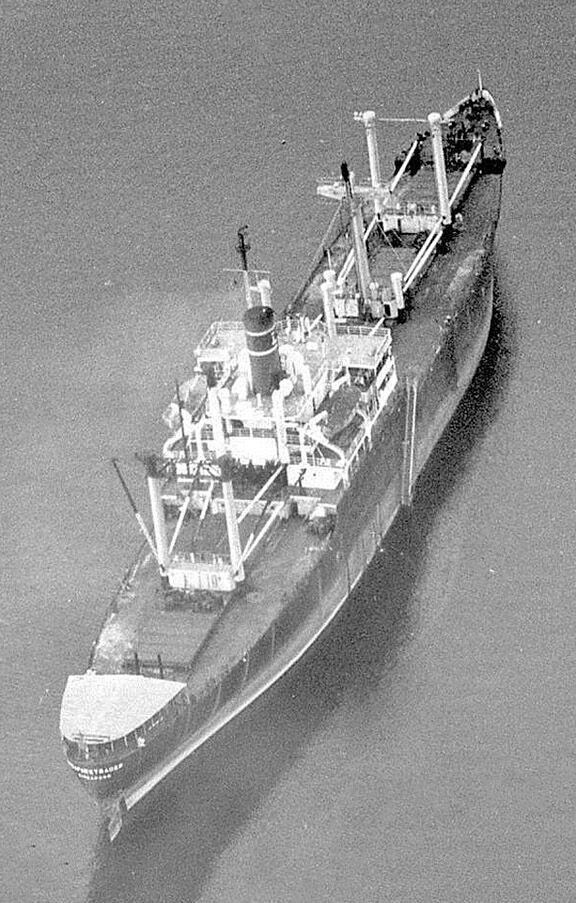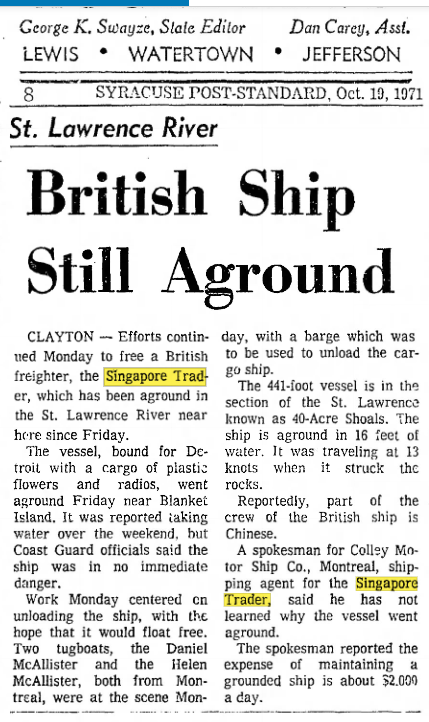The 'Singapore Trader' Carrying Christmas Decorations From Hong Kong to New York City Took an Unplanned Detour To Detroit That Came to an Abrupt End on Shoals Near Clayton, NY.
October 16, 1971: The 'Singapore Trader', a 440-foot freighter, went "hard aground" at 4:26 this morning off Blanket Island, two miles above Clayton in the St. Lawrence River, in the section known as 40 Acre Shoals (Media Reports)
At the time of the grounding, I was Director of Communications at the St. Lawrence Seaway Development Corporation, the federal agency within the US Department of Transportation (DOT), which operates the Snell and Eisenhower locks at Massena, NY, and oversees the movement of commercial traffic from the New York/Quebec border to Lake Ontario. I was on a year-long leave of absence from the Congressional staff to join the Seaway Corporation. In that role, I was responsible for establishing a working relationship with hundreds of news outlets in the US, Canada, and the Great Lakes, as well as national and international maritime media with interests relating to the Seaway system.
Shortly after the grounding, my office phone started ringing off the hook with inquiries from newspapers and broadcast media stateside, as well as many queries from Southeast Asia. After conferring with the Seaway Administrator and my DOT counterparts in Washington (who were also taking media calls, which they transferred to my office in Massena, NY), it was agreed that I should visit the grounding site to gain firsthand knowledge of the situation. After coordination with the Coast Guard (then a sister administration within DOT), I drove from Massena, the Seaway's operations headquarters, to Clayton, to assess the situation, which would put me in a stronger position to respond to the media. I was accompanied by Dominic (Ducky) Tricase, a staff photographer in my office, to document the situation for Washington.

Since the ship's meat supply had not passed US inspection when it had entered American waters, it was required to seal its meat lockers. The crew was destined to eat rice and soup until it left US waters. Some crew members were fishing from the ship, but the 40 Acre shoals area of the River is not a prime fishing location. However, the crew seemed happy with their daily catch of yellow perch, to round out their meals.
We had heard earlier that the crew were having difficulty dealing with their plight, as cold nighttime winds and fears of bad weather added to their distress. A commercial tug from Kingston, experienced in such situations, had itself become grounded enroute to the Trader. At the same time, the crew had heard from the bridge that squabbles between the ship owners, shipping agents, and the shipper, amongst others, had begun thousands of miles away. Little did they know that their grounding at 40 Acre Shoals would last for weeks.
The Coast Guard sent a launch from Wellesley Island to take us to and from the Clayton docks on Riverside Drive. I wondered how we would get from the launch onto the ship, but I soon found out. A gangplank was lowered by ropes to provide us the means to climb aboard. It was a smooth steel ramp, with no rungs or steps of any kind, only small ridges for traction between railings, which did not inspire my confidence as it swayed against the ship. I didn't want to show my apprehension, but I felt like I was climbing Mt. Everest barefoot. We worked our way up with no problem, but going down later was a challenge for someone like me, who does not like heights. However, I made it down without embarrassing myself.
Once on board the ship, we encountered the largely non-English speaking crew. They didn't know who we were, and the Seaway Corporation patches on our jackets brought fear to their eyes. Were we some type of American policeman, or immigration agents, ready to handcuff them? The captain and his bridge officers were apprehensive, apparently fearing that our mission was an unwelcome one of investigation by the US Government.
Hardly.
Anticipating the possibility of such problems, on arrival in Clayton, I had stopped at Reinmans newsstand and purchased packages of cigarettes and tobacco as gifts for the crew, with Laura Reinmans donating a number of candy treats. Once the crew realized that we were not there to arrest them, they were reassured and nodded and smiled, as we distributed our offerings. The seamen were glad to have visitors, although the language barrier put a damper on our conversations.
It was a difficult salvage operation, and the ship was not refloated until November 29th. Next, she underwent a Coast Guard safety inspection at the Port of Ogdensburg. Once the kerfuffle between the agents, shippers, etc. was over, the ship departed the seaway for Montreal, on the end of a tow line. Lawsuits were being readied.

Why in the Seaway?
Since the Singapore Trader was not a Seaway "regular," what had brought her to the St. Lawrence in the first place?
Here's the reason: In early October, the ship's owner faced a problem. She had sailed from Hong Kong on August 22nd bound for New York with a cargo of 74,641 paper cartons, consisting mainly of goods destined for the New York City's 1971 Christmas market. 472 bills of lading covered the cargo. At the time of its sailing, there was the possibility that a longshoreman's strike on the West Coast might spread to the East Coast. In anticipation of this possibility, a hand-stamp was superimposed on each bill of lading stating that "all USA cargo will be discharged at the nearest non-union port(s) not on strike.”
The Trader arrived in Brooklyn on September 18th. When 15-20% of the cargo had been unloaded, a strike materialized and forced a cessation of work at midnight. The nearest non-union ports were in Canada. The shipowner's agent advised the shipowner that the Ports of St. John, Halifax, Quebec, and Montreal would be unavailable since they were union-controlled.
On October 6th, the shipowner agreed to proceed to Detroit, a non-union port with adequate facilities for immediate discharge and cargo delivery. The Trader departed New York for Detroit on October 7th, and, after a stop in Montreal, expected to arrive in Detroit on the 16th. If all had gone well, the Christmas cargo would have appeared in countless homes in the New York City area, but for its grounding near Clayton.
Numerous legal challenges were raised relating to liability, the "discretion" of the parties, and unreasonable deviation of course to Detroit, when Valleyfield, near Montreal, was overlooked. The court found that "negligent navigation" was "clearly supported by the evidence." The court said, "there is interesting speculation . . . if the freighter had turned in at Valleyfield, it would not have had to traverse the Seaway . . . if the pilot had not momentarily retired to make some financial instead of navigational calculations, the Trader may not have gone off course."
Early Days
What a sad contrast to the ship's early days! She was built at Wilmington, NC, in 1944 and then immediately rebuilt at Hoboken, NJ, as a WW II attack cargo ship. As the USS Torrance, the vessel served the United States Navy, carrying military supplies and landing craft to support the amphibious operations in the Pacific as the Allied Forces put pressure on Japan.
The Torrance received one battle star and she was credited with shooting down two enemy aircraft during the last days of the war. With peace achieved, the Torrance returned to the US in 1946 and was laid up on the James River in Virginia. The vessel was sold to the Alcoa Steamship Co. on September 15, 1947, and returned to service in the bauxite trade as the Alcoa Roamer. She was sold again and renamed Eldorado in 1968, then Richmond in 1970, before being resold to Far East shipbrokers. A buyer was found to keep the ship in service, and she joined the Singapore Navigation Co. as Singapore Trader in 1971.
A Sad End
After the grounding, the Singapore Trader was towed back to Montreal and docked. Eventually, she was offered for sale by a court order and ultimately towed to Santander, Spain, arriving on June 22, 1972, for dismantling.
Post Script: The number “4” was not a lucky one for the Singapore Trader. It was built in 1944. It went aground on 40 Acre shoals, where she stayed for 44 days. The 440 foot ship went aground at 4:26 am. Coincidence . . . ?
By Cary R. Brick
Cary Brick is a frequent contributor to thousandislandslife.com and he has lifelong ties to the Thousand Islands. He served on the staff of the US Congress for 30 years. In retirement, he served as Associate Village Justice in Clayton. His wife, Janet, served as Clayton Village and Town Justice.
Posted in: Volume 18, Issue 10, October 2023, History
Please click here if you are unable to post your comment.
